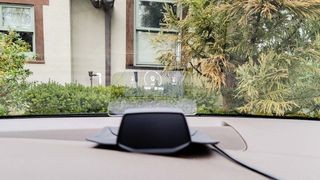A head up display (HUD) OBD2 is a game-changer for drivers seeking a safer and more informed driving experience. By projecting crucial vehicle information directly onto your windshield, a HUD OBD2 keeps your eyes on the road while providing real-time data like speed, RPM, and even navigation instructions. This article explores the benefits of using a Head Up Display Hud Obd2 and guides you through choosing the best one for your needs.
Understanding the Power of Head Up Display HUD OBD2
A head up display HUD OBD2 connects to your car’s OBD2 port, tapping into the vehicle’s computer system to access a wealth of data. This data is then displayed in a clear and concise manner on the windshield, within your line of sight. The convenience and safety benefits are undeniable: no more glancing down at the dashboard, reducing distractions and improving reaction time.
Key Advantages of a HUD OBD2 System:
- Enhanced Safety: Keeping your eyes focused on the road significantly reduces the risk of accidents.
- Real-Time Data: Access crucial vehicle information instantly, including speed, RPM, fuel consumption, coolant temperature, and more.
- Improved Situational Awareness: Be aware of your vehicle’s performance and potential issues without diverting your attention.
- Customization Options: Many HUD OBD2 systems allow you to customize the displayed information and adjust brightness for optimal visibility.
- Navigation Integration: Some advanced models offer GPS navigation, displaying turn-by-turn directions directly on your windshield.
Hudway Drive, a premium HUD OBD2 option.
Choosing the Right Head Up Display HUD OBD2: Features to Consider
The market offers a wide range of head up display HUD OBD2 options, each with its own set of features and price points. Consider these factors when making your decision:
- Display Size and Clarity: Opt for a display size that’s comfortable to read without obstructing your view. Ensure the projected image is sharp and clear, even in bright sunlight.
- Compatibility: Confirm that the HUD OBD2 system is compatible with your vehicle’s make and model. Check the OBD2 protocol compatibility as well.
- Data Parameters: Determine which data points are most important to you and choose a HUD that displays them. Common options include speed, RPM, fuel economy, engine temperature, and battery voltage.
- Connectivity: Decide if you need GPS navigation or smartphone integration. Some HUDs offer Bluetooth connectivity for displaying phone calls and notifications.
Pyle PHUD180BD, a budget-friendly HUD with a large display.
- Mounting and Installation: Look for a HUD with a secure and easy-to-install mounting system. Consider the size and placement of the unit to ensure it doesn’t interfere with your driving visibility.
- Power Source: Most HUD OBD2 systems draw power directly from the OBD2 port. However, some may require a separate power connection.
- Price: Head up display HUD OBD2 prices vary widely depending on features and functionality. Set a budget and find a model that meets your needs without breaking the bank.
Wiiyii C1, a HUD OBD2 combining GPS and OBD data.
Head Up Display HUD OBD2: Investing in Driving Safety and Convenience
A head up display HUD OBD2 is a valuable investment for any driver who prioritizes safety and convenience. By providing critical information within your direct line of sight, a HUD minimizes distractions and enhances your overall driving experience. Carefully consider your needs and budget to select the best head up display HUD OBD2 system for your vehicle.
Akabane A500, a feature-rich HUD OBD2 with performance testing capabilities.
Autool X95, a specialized HUD for off-road driving.

